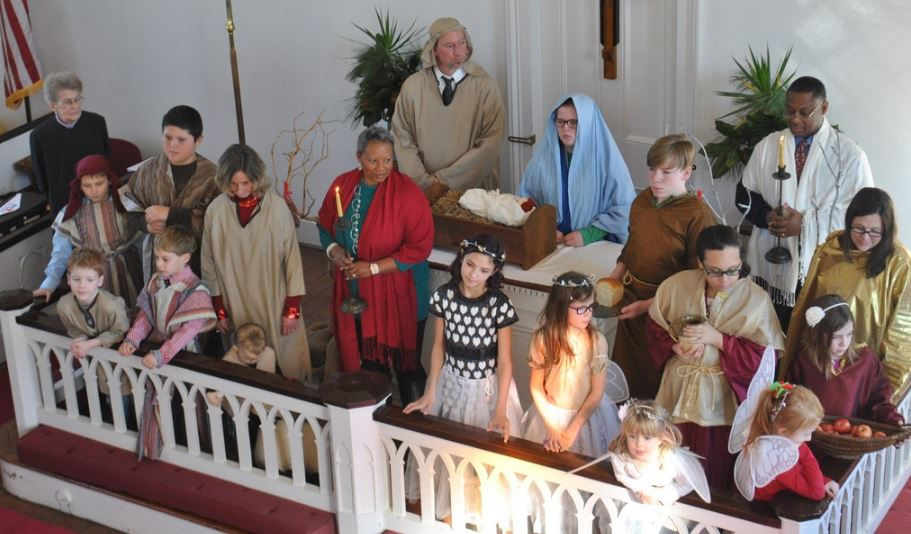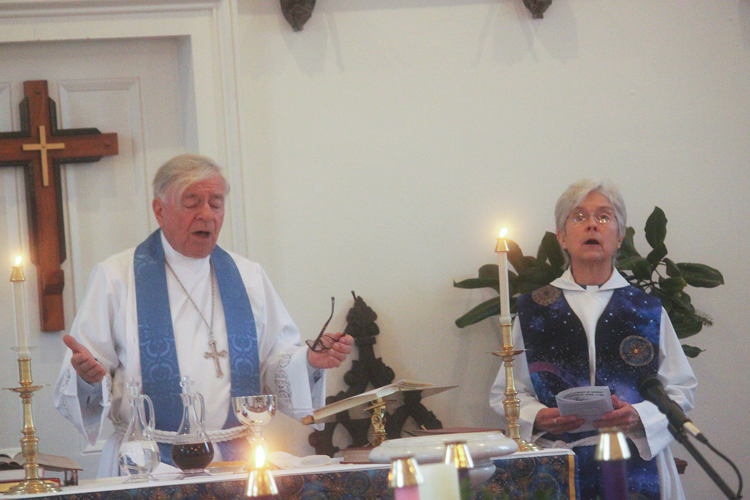2022 Sun Dec 4
Videos – Advent 2 – Dec. 4, 2022 – Christmas Play
1. 4 Part Christmas medley – Larry Saylor
2. Lighting of the 2nd Advent Candle
3. Youth readers
4. Homily
5. Christmas play – Streamed Note: You may need to turn the volume up
6. Christmas play – Filmed
6. Christmas play – Filmed 2
St. Peter’s Chrismas Play, a 25 year tradition

St. Peter’s Christmas play has been different from the typical Children’s Church play. It will be held on 2nd Advent this year, Dec. 3, 2022
First it has involved parishioners of all ages and not just children. Second it takes up most of the Sunday service. Lastly the play is written fresh every year. No repeats. The tradition began in the 1990’s under the Rev. Karen Woodruff when there were many children in the parish.
Here is a collection of Christmas pageants from 2010.
This year St Nicholas will visit the 11AM service and the St Peter’s youth will take the lead in playing holiday music for the congregation.
Preparing the Way of the Lord – Perspectives on Advent 2
Looking at Sin, repentance and Judgement – From Ruth Frey- Trinity Episcopal NY
Matthew’s vision of Jesus’s arrival doesn’t mesh well with our conventional view of the coming of Christmas. No angels or songs here. Instead, we get a strangely dressed man in the wilderness talking about sin, repentance, and fire and calling some people vipers. Definitely not a story that fits into the chatter of a typical holiday party. Yet, John the Baptist is the entry point to meeting Jesus, who declares the reign of God.
Sin, repentance, and judgement carry a lot of negative weight for humans living in today’s world with emotions of shame, guilt, and condemnation following close behind. But what if we considered sin as a matter of how we relate to what we have — be it power, resources, or material goods?
What if we saw repentance as the correcting response when we use our power, resources, and material goods in ways that do not benefit, but rather hurt, our neighbor and the earth?
And maybe being called into judgement is a call to see the world as it really is, in all its glory and pain, and to be given another chance to respond to it all with love.
Prepare the Way – Karen Hanson
When I imagine John the Baptist urging people to prepare the way of the Lord, I think of my time as a trauma chaplain in a busy safety-net hospital in Minneapolis. It was important to have a direct path from the ambulance bay to the Stabilization Room so that our critical trauma patients could be quickly transported to life-sustaining help.
At that time the paramedics had a few corners to turn and occasionally an obstacle that had to be removed in order to get the patient where they needed to go. Years later, a redesign of the Emergency Department created a beeline straight to the Stabilization Room. It’s almost as if the planners took that Isaiah passage echoed by the Baptist literally: remove the obstacles, make the path straight, and the rough smooth so that people might be delivered from death and set on a healing path.
Christians think too small in Advent. It’s not primarily individual work that needs doing. It is not a time of exclusively private reflection. The coming of the Lord is always happening and requires lots of heavy lifting. As forgiven and free people of God in Christ, Christians are called to do the work of removing obstacles that keep people from the full, liberating deliverance of God. They are to level the hills and fill in the valleys so that everyone is on an equal footing. They are to remove any system, stumbling stone, or barrier that hinders the return. This is what it means to prepare the way of the Lord.
Contemporary Christians who seek to follow this Lord have strayed from the way of Christ if they only feed the hungry and house the homeless. These acts may save lives but they don’t transform. The way of the Lord changed the captives into the homeward bound. Jesus’ good news to the poor was intended to upend the systems of oppression that the rich have always exacted on the lowly, among them the behemoth of advanced capitalism in our present day. Preparing the way of the Lord is not just a private, individual matter. It is world-changing and rallies everyone to be involved. As Mary proclaims in the Magnificat, “He has brought down the powerful from their thrones, and lifted up the lowly” (Luke 1:52).
Preparing the way of the Lord is urgent work for Christians here and now, for there are many wounded, lowly, grieving, dying, and exiled people that need a level path to get the help they need. Preparing the way of the Lord isn’t a past event; it is ongoing. The Way is made as people walk it together.
Prepare the Way
Looking at Sin by Debie Thomas
John’s gaunt austerity is the only gateway we have to the swaddling clothes, angel’s wings, and fleecy lambs we hold dear each December. As baffling as it may seem, the holy drama of the season depends on the disheveled baptizer’s opening act. So again, why the wilderness?
For starters, because the wilderness is a place of vulnerability, risk, and powerlessness. In the wilderness, we have no safety net. To locate ourselves at the outskirts of security and power is to confess our neediness in the starkest terms. In the wilderness, we have no choice but to wait and watch as if our lives depend on God showing up. Because they do. And it’s into such an environment — an environment so far removed from safety as to make safety laughable — that the word of God comes.
“Sin.” We associate it with shame, guilt, and condemnation.
Advent begins with an honest, wilderness-style reckoning with sin. We can’t get to the manger unless we go through John, and John is all about repentance. Is it possible that this might become an occasion for relief? Maybe, if we can get past our baggage and follow John out into the wilderness, we will find comfort in the fact that something more profound is at stake in our souls than, “I make mistakes sometimes,” or “I’ve got a few issues.” What ails is something deeper, grimmer, and far more consequential.
Sin, at its heart, is a refusal to become fully human. It’s anything that interferes with the opening up of our whole hearts to God, to others, to creation, and to ourselves. Sin is estrangement, disconnection, sterility, disharmony. It’s the sludge that slows us down, that says, “Quit. Stop trying. Give up. Change is impossible.”
Sin is apathy. Care-less-ness. A frightened resistance to an engaged life. Sin is the opposite of creativity, the opposite of abundance, the opposite of flourishing. Sin is a walking death. And it is easier to spot, name, and confess a walking death in the wilderness than it is anywhere else.
John underscores his message of repentance with a harrowing description of the coming Messiah
I wonder if we squirm because we misconstrue the meaning of judgment. I tend to equate judgment with condemnation, but in fact, to judge something is to see it clearly — to know it as it truly is. In my dictionary, synonyms for judgment include discernment, acuity, sharpness, and perception.
What if John is saying that the Messiah who is coming really sees us? That he knows us at our very core? Maybe the winnowing fork is an instrument of deep love, patiently wielded by the One who discerns in us rich harvests still hidden by chaff. Maybe it’s in offering God every particular of our lives that we give Him permission to “clear” us — to separate all that’s destructive from all that is good, beautiful, and worthy.
Finally, Matthew suggests that the wilderness is a place where we can see the landscape whole, and participate in God’s great work of leveling inequality and oppression.
Unless we’re in the wilderness, it’s hard to see our own privilege, and even harder to imagine giving it up. No one standing on a mountaintop wants the mountain flattened. But when we’re wandering in the wilderness, and immense, barren landscapes stretch out before us in every direction, we’re able to see what privileged locations obscure. Suddenly, we feel the rough places beneath our feet. We experience what it’s like to struggle down twisty, crooked paths. We glimpse arrogance in the mountains and desolation in the valleys, and we begin to dream God’s dream of a wholly reimagined landscape. A landscape so smooth and straight, it enables “all flesh” to see the salvation of God.
Where are you located during this Advent season? How close are you to security and power, and how open are you to risking the wilderness to hear a word from God? What might repentance look like for you, here and now? Where is God leveling the ground you stand on, and what will it take for you to participate in that uncomfortable but essential work?
Debie Thomas: The Voice of One Crying
https://www.journeywithjesus.net/essays/2470-the-voice-of-one-crying
Bulletin, Second Sunday of Advent, Dec. 4, 2022
Click here to view in a new window.
Newsletter, December, 2022
Click here to view in a new window.
Advent 2 – Peace

One of the hallmarks of the Christmas story is when the angels appear to the shepherds and proclaim, “Peace on earth,” in Luke 2:14.
Jesus brought about peace, in the most unexpected ways, when he arrived. The Jews, particularly the zealots, wanted a rebellion. They wanted their Savior to overturn the oppressive rule of the Romans and bring about peace in a violent way.
But Jesus had something else in mind. Jesus brings us peace in a number of ways.
First, he gives us inner peace. Because of his work on the cross, we have a chance to receive salvation and be indwelled by the Holy Spirit. This grants us an inner peace (John 14:27). Not only do we have the peace that comes from our assurance of salvation, but we also have the peace of mind knowing God will heal this broken world and will come again.
Second, we have peace with others. We put aside our differences (Galatians 3:28), especially with other believers, because we belong to the same family. We have the same purpose: to let others know about the peace of Christ.
The Hebrew word for peace: Shalom, goes far beyond not fighting with others or peace as we know it. Shalom which means completeness or well being. Jesus did not come just to end wars, but to make us complete by saving us from our sinfulness. As pointed out in the book Not the Way It’s Supposed to Be, shalom is, in essence, how things are meant to be: a slice of heaven.
The peace of God allows us to look at others through heaven’s eyes and help guide the world to see God’s here and not-yet here kingdom.
Peace from God, biblical peace, allows us to trust in God’s promises (Proverbs 3:5), through restful, tranquil faith, despite the dark, scary world around us.
Arts and Faith, Advent 2, Year A —
Absolon Stumme’s 1499 altarpiece presents a mystical depiction of one of Advent’s key symbols—the tree of Jesse. Jesse’s tree is a royal symbol: a lineage flourishing from Jesse through David down the centuries to the birth of Christ, our King of Kings. The tree branches out to show others in this lineage, names of ancestors that Matthew and Luke preserve for us in the Gospels. We see the evangelist on the left, holding a scroll, pointing to this lineage in Scripture, as this vivid depiction of it surrounds him. The tree is fantastical—a golden flower that buds forth with the ancestors of Christ. On top of the tree, the Christ-child reigns in golden light.
Crowning this royal lineage, the Christ-child is a strange symbol of sovereignty. He is small, naked, held by his mother—an image of utter dependence. Yet, the words of Isaiah echo here: “Not by appearance shall he judge,” as his reign brings about justice and peace. With the reign of this strange, small king, our perceptions are tested as well: what is true power, what is true glory, what is true success? As the wolf pairs with the lamb, the leopard with the goat, and the calf with the young lion, we get hints from Isaiah for answers to these questions.
On the bottom of the tree, Jesse sleeps—an allegory that brings to mind the sleeping Adam, while God fashioned Eve from his side. From the sleeping Jesse, God brings forth a new lineage—the royal lineage that proclaims the sovereignty of God. The tree that sprouts out from him is like a dream, a vision of hope for justice, peace, and faithfulness to reign over the suffering, turmoil, and despair of our world. In the fullness of time, Jesse’s dream becomes a reality, his hope made present in Jesus Christ, his descendant and Savior. What hopes do you harbor as we await Christ’s coming this Advent?
Advent Thoughts
Advent is a season of Watching and Waiting. It is a season of leaning into hope
Lord Jesus: Come into our world and heal its wounds Come into your church and raise it up Come into our homes and make them holy Come into our work and make it fruitful Come into our minds and give us clarity Come into our lives and make them beautiful O Come, O Come Emmanuel
God of the past, the present and the future, grant me patience when I must wait, courage when it’s time to take action, and the wisdom to know when to wait and when to act. Amen.
Advent 2


Explore Advent, Part 2
“Advent is a time to look for “desert places”: the place of solitude, the place of true silence in which we can become fully awake to our sin and God’s forgiving grace which alone can heal it.”-Br. Robert L’Esperance
This week we focus on John the Baptist through scripture, art and commentary. Let’s move to Advent 2.


St Nicholas Day is December 6.
Here is a presentation that provides the background of this saint who has had a colorful and varied history over 1800 years.

A collection around the following 6 categories:
![]()
 READ!
READ!
1 What Does This Season Mean? Though Advent appears at the end of the secular calendar year, it is the beginning of the Christian year. The deep darkness of the natural world around us is an echo of the nurturing darkness of the dawning of Creation. It is in this holy space we begin re-telling our Sacred Stories. The word “Advent” comes from the Latin adventus, which means “coming” or “arrival.” Advent prepares us for, and leads us to, Jesus’ birth in Bethlehem. The four Sundays in Advent invite us on a journey. As the days grow shorter each week, we are invited to draw closer and closer to the light of Christ. We are invited to open our hearts a little wider each week to God With Us.
2 Three Teaching Points of Advent – Sarah Bentley Allred https://bit.ly/2HMHfA2
3 The way we begin Advent is different. Each year, the First Sunday of Advent starts the church’s liturgical calendar, and our countdown to Christmas, with a set of haunting, apocalyptic readings https://buildfaith.org/apocalyptic-advent-in-the-season-of-merry-and-bright/
4 Advent Waiting Article explores three qualities of Advent waiting – expectant, requires us to make space, and is hopeful.
5 Waiting and Unknowing by Fr. Richard Rohr. Once Thanksgiving is over, we in the United States are rushed headlong into the Christmas season. Yet Advent was once (and still can be) a time of waiting, a time of hoping without knowing, a time of emptying so that we can be filled by the divine Presence.
6 Advent as an introvert Season – Advent is expectant and full of hope. “There’s also a solemn quality to the waiting — not dour or dreary — something grounded and okay with a close stillness, a quality that honors the waiting itself as sacred.” https://onbeing.org/blog/the-shoulder-season-of-advent/
7 Advent mediations from Living Compass. Read it here
The key word is “simplicity”. “We are talking about a practice of simplicity on a much deeper level. This is the kind of simplicity that people talk about when they describe being in the midst of a crisis, and then later report that the crisis has caused them to rethink their priorities, to focus on what is truly most essential in their lives.”
“So let us embrace whole-heartedly the season of Advent, along with these reflections, as the support we need to practice simplicity in a way that will help prepare us for the true meaning of Christmas.”
“The Living Compass Model for Well-Being offers us guidance in four dimensions of our being: heart, soul, strength, and mind. Our call is to live an undivided life, where heart, soul, strength, and mind are integrated into both our being and our doing.” Quotes begin on Page 44
 WATCH
WATCH
1 Nativity: The Art and Spirit of the Creche. After the cross, the Nativity scene is Christianity’s most recognized symbol. Its history, art and spirituality have been embraced by cultures around the world for nearly two thousand years. This video unites theologians and collectors with an astonishing and beautiful array of nativity scenes collected from across the globe. https://www.youtube.com/embed/M29ShR-V9Pk
2 The Story of Silent Night – Classic Collection In the quiet of an Austrian winter, a young priest received heavenly inspiration to commemorate the most significant event in history by writing the world’s most beloved Christmas carol, “Silent Night.” https://youtu.be/nKn9wLLzha8
 LEARN!
LEARN!
1 Luke’s canticles – Combines four stories from Luke with insights from artists, prayers, and hymns from around the world. Based on Songs in Waiting by Paul Chandler, now the Bishop of Wyoming https://www.churchsp.org/course/lukescanticles/
2 Matthew’s Infancy Stories. The other author of the infancy stories, much different than Luke above https://www.churchsp.org/course/matthewsinfancystories/”
3 Christmas Carols – They surround us at Christmas. How much do you know about them?https://www.churchsp.org/course/12daysofcarols/
4 Handel’s Messiah, Prophesy and Birth of the Messiah. The premiere Christmas work with the music and text https://www.churchsp.org/course/handels-messiah-part-1-prophecy-and-birth-of-the-messiah/
5. Dickens A Christmas Carol and the Bible. The premiere Christmas novel, here with the influence of the Bible and much of Dickens time https://www.churchsp.org/course/dickens/
 LISTEN!
LISTEN!
1 O Emmanuel A fresh exploration of the O Antiphons including traditional Advent and Christmas music. The album combines a jazz trio with children’s choir and adult voices in just the right mix of expectation and joy. https://music.apple.com/us/album/o-emmanuel/1151565367
2 Advent Lessons and Carols – Washington National Cathedral The classic way to begin Advent – Scripture and music with a service for the season. Previous service https://www.youtube.com/watch?v=wwR1FJ3-dts&t=3s , Nov. 27, 2022 service, 4pm https://cathedral.org/event/advent-lessons-and-carols-4/
3. Still Forming Advent Meditations by Christianne Squires is a collection of audio meditations recorded by Christianne Squires for the Still Forming community, based on Jan Richardson’s book of blessings, Circle of Grace https://www.stillforming.com/still-forming-advent-meditations-2015
4 Spotify Play list Advent with Sacred Ordinary Days on Spotify. Listen and prepare for our Savior, with anticipation, longing and hope
 PRAY AND REFLECT!
PRAY AND REFLECT!
1 Advent meditations. In this workshop, Rev. Hillary Raining, D.Min. guides you through a meditation with prayer, scripture, and reflection using visio Divina, or “divine seeing,” with candlelight. http://lifelonglearningvts.teachable.com/p/advent-meditation-workshop/?src=email
2 Antiphons for Advent in English and Spanish for 2022 A devotional resource in English and Spanish created from antiphons that families and communities can use daily in Advent. The short liturgy includes a prayer for lighting candles of an Advent wreath.
An antiphon is the brief snippet of a psalm recited or chanted as a refrain at the beginning and/or end of a psalm or canticle. Antiphons were in use by the 5th century and are still in use during the services of daily prayer. The practice comes from the Jewish tradition of the congregation reciting, chanting, or singing together, the word referring to call-and-response type of singing. https://buildfaith.org/wp-content/uploads/2022/10/Advent-Antiphons.ENG_.2022.pdf
3 Journey on the Way of love. Designed for Christian Formation (“Sunday School”). There are 4 sessions for the 4 weeks of Advent The Way of Love is based on a rule of life. The best known rule of life developed in Christian monastic communities is that of St Benedict, dating from the 6th century. https://www.episcopalchurch.org/journeying-way-love/
 MAKE!
MAKE!
3 Families celebrate Advent and Christmas Families Celebrate Advent & Christmas is a colorful deck of cards that is full of rituals, prayers and reflections. Endlessly flexible for busy schedules, you can create a new after-meal ritual, use them as decorations, or carry them on the go. https://www.augsburgfortress.org/store/product/9781506483498/Families-Celebrate-Advent-and-Christmas-2022-23 Free promo pack at bottom!
4 Create your own advent calendar 20 advent calendars to make. https://www.parents.com/holiday/christmas/crafts/best-advent-calendars/.
5 Advent wreaths on a Budget In congregations that have tight budgets, making Advent wreaths with families may be out of reach. While making wreaths is a wonderful parish life event, buying the foam inserts, ring trays, five candles and four stakes can add up to a hefty sum. Here is an alternative solution https://buildfaith.org/99-cent-advent-wreath/
Here is another wreath article from Episcopal Relief that go up to $50 in cost.
Sunday links for Dec. 4, 2022

Service, Advent 1, Nov. 27, 2022
Coming up!
Dec. 4, 11:00am – Advent 2
Dec. 4, Christmas Play on Second Advent
Dec. 4, St. Nicholas coffee hour after church
Dec. 4, Bethlehem Walk trip, leave after Church
Dec. 9, Greening of the Church, 10AM – Alice Hughes
Dec. 11, Deadline for Easter gifts to the Episcopal Church Men (ECM)
Dec. 18, Deadline for General Endowment Fund donations
